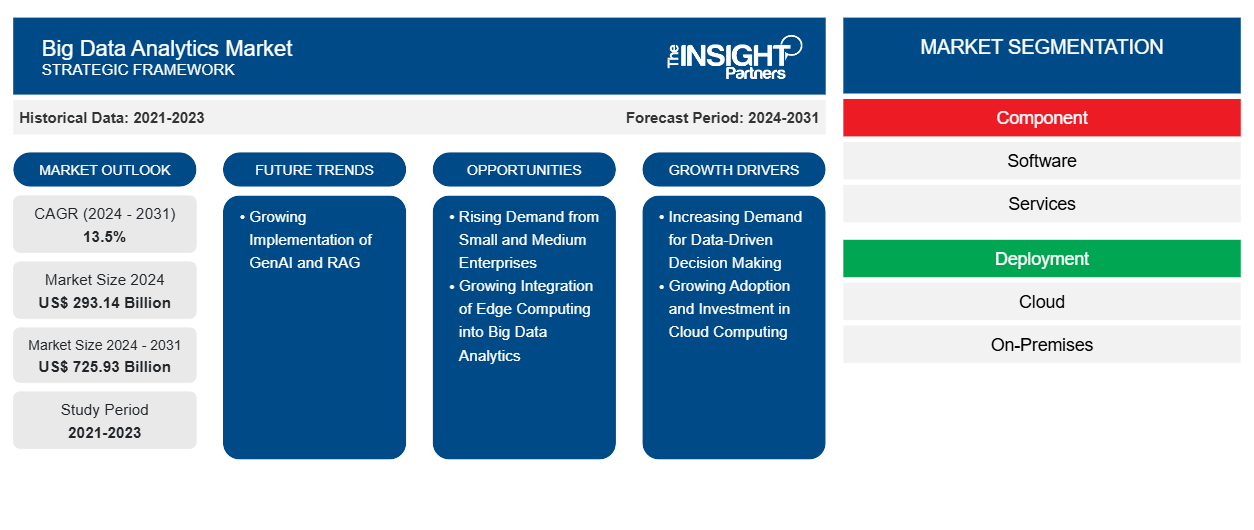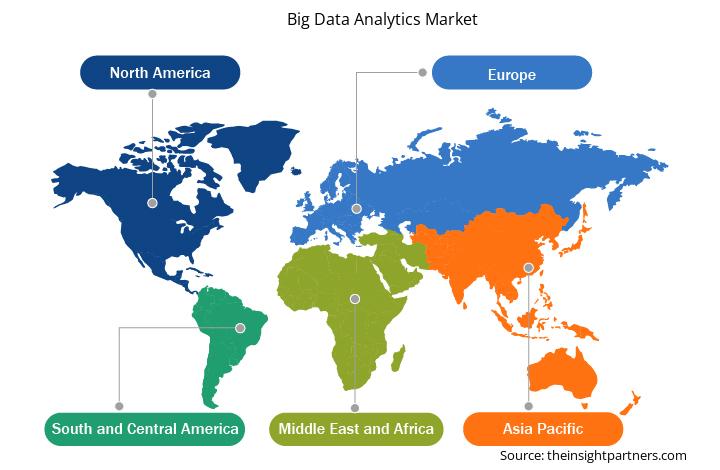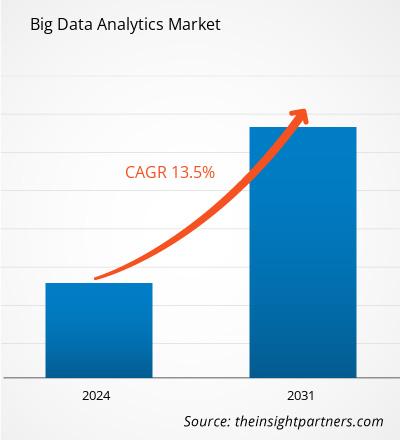The big data analytics market size is projected to reach US$ 725.93 billion by 2031 from US$ 293.14 billion in 2024. The market is expected to register a CAGR of 13.5% during 2025–2031. The growing implementation of GenAI and RAG is likely to bring new trends into the market in the coming years.
Big Data Analytics Market Analysis
Factors such as increasing demand for data-driven decision-making and growing adoption and investment in cloud computing are driving the big data analytics market. The market is expected to grow during the forecast period owing to the rising demand from small and medium enterprises (SMEs) and the growing implementation of edge computing into big data analytics. The implementation of GenAI and RAG is likely to bring new trends to the market in the coming years. Moreover, the market is witnessing significant growth, driven by the increasing size of data produced across industries and the growing need for organizations to derive actionable insights from this data. Other drivers include the widespread adoption of Internet of Things (IoT) devices, social media platforms, and smart devices, which generate massive amounts of data that require advanced analytics to extract meaningful information.
Big Data Analytics Market Overview
The rising emphasis on cost reduction and operational efficiency is encouraging businesses to invest in big data analytics solutions. Opportunities are emerging in industries such as healthcare, retail, finance, and manufacturing, where data analytics can enhance customer experiences, optimize supply chains, improve financial decision-making, and enable predictive maintenance. Moreover, the integration of artificial intelligence (AI) and machine learning (ML) with big data analytics is opening up new possibilities for predictive modeling, personalized recommendations, and automation. In terms of future trends, the market is expected to witness the increasing adoption of cloud-based big data solutions as businesses seek scalability, cost-effectiveness, and remote access to analytics platforms.
Customize This Report To Suit Your Requirement
You will get customization on any report - free of charge - including parts of this report, or country-level analysis, Excel Data pack, as well as avail great offers and discounts for start-ups & universities
Big Data Analytics Market: Strategic Insights

- Get Top Key Market Trends of this report.This FREE sample will include data analysis, ranging from market trends to estimates and forecasts.
You will get customization on any report - free of charge - including parts of this report, or country-level analysis, Excel Data pack, as well as avail great offers and discounts for start-ups & universities
Big Data Analytics Market: Strategic Insights

- Get Top Key Market Trends of this report.This FREE sample will include data analysis, ranging from market trends to estimates and forecasts.
Big Data Analytics Market Drivers and Opportunities
Growing Adoption and Investment in Cloud Computing
The growing adoption and investment in cloud computing fuels the growth of the big data analytics market. Organizations are increasingly leveraging cloud technologies to process and analyze massive amounts of data. This shift is transforming the way businesses approach data management, scalability, and analytical capabilities. Cloud computing provides better infrastructure, cost efficiency, scalability, and advanced features required to harness the full potential of big data analytics, enabling businesses to make data-driven decisions more effectively and efficiently. Major companies are investing in AI and cloud computing infrastructure, which is further boosting the adoption of big data analytics worldwide. A few examples are mentioned below:
- In October 2024, Microsoft made a significant commitment to invest € 4.3 billion (US$ 4.75 billion) in expanding its cloud and artificial intelligence (AI) data center infrastructure in Italy, highlighting the company’s strategic focus on bolstering its position in the rapidly growing market for data analytics in Europe. This investment further supports cloud computing in the region as it is already experiencing robust growth, driven by increasing demand for advanced AI solutions, big data analytics, and digital transformation services. The expansion will enhance Microsoft’s capabilities in providing scalable, secure, and high-performance cloud services as well as align with the growth of big data analytics in Europe.
- In June 2024, in response to the surging demand for AI and cloud services in Spain, Oracle unveiled plans to invest over US$ 1 billion in establishing a third cloud region in Madrid. This initiative aims to accelerate the development of AI expertise nationwide while enhancing cloud capabilities for Oracle’s customers and partners, particularly in sectors such as financial services. The expansion reflects the broader trend of growing big data analytics adoption across Europe, as businesses increasingly seek advanced cloud solutions to leverage data-driven insights and drive innovation in industries such as finance and healthcare.
Growing Integration of Edge Computing into Big Data Analytics
Distributed data processing enables data to be analyzed and processed closer to its source, reducing dependence on centralized cloud infrastructure and facilitating real-time insights. Edge devices can handle complex pre-processing and filtering tasks, which help optimize cloud resources for advanced analytics. This faster data processing allows for the rapid identification of trends and anomalies, enhancing decision-making at the operational level.
Edge computing paves the way for emerging applications such as predictive maintenance for industrial equipment, real-time traffic management, and personalized recommendations in retail, fostering innovation across various industries. The growth of edge computing is revolutionizing big data analytics by enabling data to be processed closer to its source, providing businesses with real-time insights, enhancing operational efficiency, and opening up new application opportunities. Despite existing challenges, ongoing technological advancements and a strong emphasis on security are set to facilitate the smooth integration of edge computing with big data analytics, driving further innovation and improvements in business operations.
Advancements in chip technology, software optimization, and security protocols are set to address existing challenges. The emergence of standardized edge computing platforms will make the technology more accessible, simplifying both deployment and management. Additionally, on-device AI and machine learning will enable faster and more advanced data analysis closer to the source. Edge computing will also complement cloud-based analytics, fostering a hybrid architecture that optimizes data processing and storage. As the technology evolves, a strong focus on security and privacy will be necessary to ensure responsible edge computing practices.
Thus, the rising integration of edge computing into big data analytics is expected to create opportunities for the market growth during the forecast period.
Big Data Analytics Market Report Segmentation Analysis
Key segments that contributed to the derivation of the big data analytics market analysis are component, deployment, application, and end-user industry.
- Based on component, the big data analytics market is divided into software and services. The software segment held a larger share of the market in 2024.
- In terms of deployment, the big data analytics market is bifurcated into cloud and on premises. The cloud segment held a larger share of the market in 2024.
- Based on application, the big data analytics market is segmented into customer analytics, marketing analytics, pricing analytics, workforce analytics, and others. The others segment dominated the market in 2024.
- In terms of end-user industry, the big data analytics market is segmented into IT and telecom, BFSI, healthcare, retail, and others. The others segment held the largest share of the market in 2024.
Big Data Analytics Market Share Analysis by Country
The geographic scope of the big data analytics market report is mainly divided into North America, Europe, Asia Pacific (APAC), the Middle East & Africa (MEA), and South & Central America.
The UK held a significant share of the market in 2024. In October 2024, four major US companies unveiled plans to invest £ 6.3 billion (US$ 78.3 billion) in the UK’s data infrastructure. This announcement, made at the International Investment Summit, was hailed by the Technology Secretary as a “vote of confidence” in the UK’s strategy of collaborating with businesses to boost economic growth. CyrusOne, ServiceNow, CloudHQ, and CoreWeave are a few companies committing substantial investments, contributing to a total investment of over £ 25 billion (US$ 31.1 billion) in UK data centers. These new facilities will significantly enhance the country’s computing power and data storage capabilities, which are crucial for the development and deployment of next-generation AI-based technologies. Further, this substantial investment highlights the rapid growth of the big data analytics market in the UK, which continues to expand as businesses increasingly recognize the need for robust data infrastructure. With these new data centers, the UK is positioning itself as a key player in the global data economy, offering the necessary resources to support the growing demand for data-driven solutions, AI, and machine learning. As the need for advanced data analytics continues to rise across sectors such as healthcare, finance, and manufacturing, the expansion of the UK’s data infrastructure is critical to fostering innovation and maintaining a competitive edge in the digital age. This influx of investment strengthens the UK’s position as a data hub as well as fuels the country’s broader digital transformation initiatives.
Big Data Analytics Market Regional Insights
The regional trends and factors influencing the Big Data Analytics Market throughout the forecast period have been thoroughly explained by the analysts at The Insight Partners. This section also discusses Big Data Analytics Market segments and geography across North America, Europe, Asia Pacific, Middle East and Africa, and South and Central America.

- Get the Regional Specific Data for Big Data Analytics Market
Big Data Analytics Market Report Scope
| Report Attribute | Details |
|---|---|
| Market size in 2024 | US$ 293.14 Billion |
| Market Size by 2031 | US$ 725.93 Billion |
| Global CAGR (2025 - 2031) | 13.5% |
| Historical Data | 2021-2023 |
| Forecast period | 2024-2031 |
| Segments Covered |
By Component
|
| Regions and Countries Covered | North America
|
| Market leaders and key company profiles |
Big Data Analytics Market Players Density: Understanding Its Impact on Business Dynamics
The Big Data Analytics Market is growing rapidly, driven by increasing end-user demand due to factors such as evolving consumer preferences, technological advancements, and greater awareness of the product's benefits. As demand rises, businesses are expanding their offerings, innovating to meet consumer needs, and capitalizing on emerging trends, which further fuels market growth.
Market players density refers to the distribution of firms or companies operating within a particular market or industry. It indicates how many competitors (market players) are present in a given market space relative to its size or total market value.
Major Companies operating in the Big Data Analytics Market are:
- Amazon Web Services Inc.
- FICO
- Hewlett Packard Enterprise Co
- International Business Machines Corp
- Microsoft Corp
- Oracle Corp
Disclaimer: The companies listed above are not ranked in any particular order.

- Get the Big Data Analytics Market top key players overview
Big Data Analytics Market News and Recent Developments
The big data analytics market is evaluated by gathering qualitative and quantitative data post primary and secondary research, which includes important corporate publications, association data, and databases. A few of the developments in the big data analytics market are listed below:
- SAS announced a new distribution agreement with Carahsoft Technology Corp., the trusted government IT solutions provider. Under the agreement, Carahsoft will serve as an SAS Public Sector Distributor, making the company’s analytics, AI, and data management solutions available to US Government agencies through Carahsoft’s reseller partners and various contract vehicles and government schedules. (Source: SAS Institute’s Inc., Press Release, February 2024)
- Teradata, the connected multi-cloud data platform, unveiled a new analytic integration component for Dataiku, the “everyday AI” platform. The new Teradata Plugins for Dataiku are intended to allow analytics and data science teams who utilize Dataiku to execute various analytic operations within the Teradata Vantage platform. (Source: Teradata Corp, Press Release, December 2021)
Big Data Analytics Market Report Coverage and Deliverables
The “Big Data Analytics Market Size and Forecast (2021–2031)” report provides a detailed analysis of the market covering below areas:
- Big data analytics market size and forecast at global and country levels for all the key market segments covered under the scope
- Big data analytics market trends, as well as market dynamics such as drivers, restraints, and key opportunities
- Detailed PEST and SWOT analysis
- Big data analytics market analysis covering key market trends, global framework, major players, regulations, and recent market developments
- Industry landscape and competition analysis covering market concentration, heat map analysis, prominent players, and recent developments for the big data analytics market
- Detailed company profiles
Frequently Asked Questions
What are the future trends of the big data analytics market?
Growing implementation of GenAI and retrieval-augmented generation (RAG) is the future trends of the big data analytics market.
Which region is holding the major market share of big data analytics market?
The North America held the largest market share in 2024, followed by Europe.
What is the estimated global market size for the big data analytics market in 2024?
The big data analytics market was valued at US$ 293.14 billion in 2024 and is projected to reach US$ 725.93 billion by 2031; it is expected to grow at a CAGR of 13.5% during 2025–2031.
What will be the big data analytics market size by 2031?
The big data analytics market is expected to reach US$ 725.93 billion in the year 2031.
What are the driving factors impacting the big data analytics market?
Increasing demand for data-driven decision making and growing adoption and investment in cloud computing are the driving factors impacting the big data analytics market.
Which are the key players holding the major market share of big data analytics market?
The key players, holding majority shares, in big data analytics market includes IBM Corporation, Microsoft Corporation, Oracle Corporation, and SAP SE.
- Historical Analysis (2 Years), Base Year, Forecast (7 Years) with CAGR
- PEST and SWOT Analysis
- Market Size Value / Volume - Global, Regional, Country
- Industry and Competitive Landscape
- Excel Dataset
- Parking Meter Apps Market
- eSIM Market
- Advanced Distributed Management System Market
- Online Exam Proctoring Market
- Electronic Data Interchange Market
- Barcode Software Market
- Maritime Analytics Market
- Cloud Manufacturing Execution System (MES) Market
- Robotic Process Automation Market
- Digital Signature Market
Testimonials
Reason to Buy
- Informed Decision-Making
- Understanding Market Dynamics
- Competitive Analysis
- Identifying Emerging Markets
- Customer Insights
- Market Forecasts
- Risk Mitigation
- Boosting Operational Efficiency
- Strategic Planning
- Investment Justification
- Tracking Industry Innovations
- Aligning with Regulatory Trends
Yes! We provide a free sample of the report, which includes Report Scope (Table of Contents), report structure, and selected insights to help you assess the value of the full report. Please click on the "Download Sample" button or contact us to receive your copy.
Absolutely — analyst assistance is part of the package. You can connect with our analyst post-purchase to clarify report insights, methodology or discuss how the findings apply to your business needs.
Once your order is successfully placed, you will receive a confirmation email along with your invoice.
• For published reports: You’ll receive access to the report within 4–6 working hours via a secured email sent to your email.
• For upcoming reports: Your order will be recorded as a pre-booking. Our team will share the estimated release date and keep you informed of any updates. As soon as the report is published, it will be delivered to your registered email.
We offer customization options to align the report with your specific objectives. Whether you need deeper insights into a particular region, industry segment, competitor analysis, or data cut, our research team can tailor the report accordingly. Please share your requirements with us, and we’ll be happy to provide a customized proposal or scope.
The report is available in either PDF format or as an Excel dataset, depending on the license you choose.
The PDF version provides the full analysis and visuals in a ready-to-read format. The Excel dataset includes all underlying data tables for easy manipulation and further analysis.
Please review the license options at checkout or contact us to confirm which formats are included with your purchase.
Our payment process is fully secure and PCI-DSS compliant.
We use trusted and encrypted payment gateways to ensure that all transactions are protected with industry-standard SSL encryption. Your payment details are never stored on our servers and are handled securely by certified third-party processors.
You can make your purchase with confidence, knowing your personal and financial information is safe with us.
Yes, we do offer special pricing for bulk purchases.
If you're interested in purchasing multiple reports, we’re happy to provide a customized bundle offer or volume-based discount tailored to your needs. Please contact our sales team with the list of reports you’re considering, and we’ll share a personalized quote.
Yes, absolutely.
Our team is available to help you make an informed decision. Whether you have questions about the report’s scope, methodology, customization options, or which license suits you best, we’re here to assist. Please reach out to us at sales@theinsightpartners.com, and one of our representatives will get in touch promptly.
Yes, a billing invoice will be automatically generated and sent to your registered email upon successful completion of your purchase.
If you need the invoice in a specific format or require additional details (such as company name, GST, or VAT information), feel free to contact us, and we’ll be happy to assist.
Yes, certainly.
If you encounter any difficulties accessing or receiving your report, our support team is ready to assist you. Simply reach out to us via email or live chat with your order information, and we’ll ensure the issue is resolved quickly so you can access your report without interruption.















The List of Companies - Big Data Analytics Market
- Amazon Web Services Inc
- FICO
- Hewlett Packard Enterprise Co
- International Business Machines Corp
- Microsoft Corp
- Oracle Corp
- SAP SE
- SAS Institute Inc
- TIBCO Software Inc.
- Teradata Corp






 Get Free Sample For
Get Free Sample For